
Mining is currently Mexico's fourth-largest industry, behind electronics, automobiles and energy. Most of Mexico's mining activities occur in four states: Sonora, Chihuahua, Durango and Zacatecas. Of the total copper output, 73 percent is produced in Sonora; 72 percent of silver is produced in Chihuahua, Durango and Zacatecas; and 68 percent of gold is produced in Sonora, Chihuahua and Zacatecas. These mining areas, particularly in the western Sierra Madre Mountains of Chihuahua and Durango, are located in regions that rank among Mexico's most violent and most socially and economically disadvantaged.
In 2012, mining generated $20 billion in revenues, more than 70 percent derived from gold, silver and copper production. Production of these three minerals was almost entirely exported in 2012, generating more than $13 billion in trade revenue. The industry employs roughly 330,000 people directly and 1.5 million indirectly at wages that, on average, are considerably higher than the average compensation of workers in other industries. While this is small in terms of the total 50 million-strong Mexican labor force, it is concentrated in poor areas with little alternative economic potential.
Because of Mexico's free trade agreements with the world's two largest economic zones — North America and Europe — machinery and capital can enter and minerals can exit the country largely tax and tariff free. Technically, the Mexican government has direct ownership over mineral deposits, but exploration and exploitation are permitted if the Ministry of Economy grants a concession. Unlike the energy sector, in which it is forbidden to book reserves or enter into production-sharing agreements, the mining sector is fully open to foreign investment and ownership.



